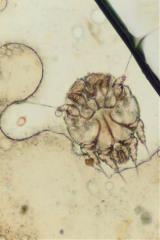Sarcoptic Mange: An Itchy Skin Disease Caused by External Parasites

A diagnosis of sarcoptic mange is always a concern.
The scabies mites that cause this irritating skin disease are highly contagious, and fast action must be taken to eliminate them.
Clinical Signs
Scabies mites burrow beneath the skin of their host. Upon examination, animals will present with symptoms that include:
- The sudden onset of intense itching, chewing, and scratching, specifically in the areas of the:
- Underside of the chest and face
- Skin of the ears
- Elbows
- Hocks
- Hair loss
- Red, raw sores on skin
- Inflamed skin
- Crusty ear tops
- Symptoms that suggest that the mites have transferred to humans include:
- Intense itching along arms, chest or abdomen
- Red rash found along the belt line or at the waistband areas.
If at any time the symptoms arise, clients should be advised to immediately contact their family physician. Scabies mites cannot complete their life cycle on a human and will die on their own without any further treatment. If the affected animal has completed treatment, any spread of the mites may indicate a continuing source of infestation, and should be investigated. Treatment of the home should be completed to prevent recurrence.
Diagnosis
The following diagnostic procedures are often used to uncover sarcoptic mange mites:
Skin scraping
The diagnosis of scabies mites requires more than the naked eye since the itching begins when the female mites tunnel below the skin to lay their eggs.
Steps to aid in the diagnosis include:
- Skin scrapings examined under the microscope
- Scabies mites localize in the stratum corneum
- The chance for a positive diagnosis is increased by completing:
- Multiple wide and superficial scrapings of the areas that exhibit as crusty, papular, or alopecic lesions
- Because scabies mites are often few in number, a positive diagnosis can still be difficult even with a skin scraping
- Mites, mite eggs can sometimes be identified through a fecal sample
Diagnosis Through Reaction
Rubbing the edge of the dog’s ear and looking to see if the animal produces a reflex scratching through one hind leg is a common reaction found in dogs with sarcoptic mange
Diagnosis by Treatment
- When the symptoms suggest scabies mites, but the diagnosis turns up negative, a treatment for scabies should be started and viewed as a diagnostic test
- If the tested treatment works, then the diagnosis has been confirmed.
The methods for treatment typically include the following:
- Clipping hair away from the affected areas will aid the effectiveness of the applied treatments
- Medicated baths, usually with a benzoyl peroxide solution, will loosen any scaling so the treatment can penetrate into the pores
- Treatment with an insecticide dip needs to be over the entire animal, not just the affected areas
- Antihistamines or corticosteroids will help to relieve the itching
- Oral and topical antibiotics will heal any sores created by itching and scratching
- Broad spectrum antibiotics will work against any developing secondary infections
- While the scabies mites tend to die quickly, they are difficult to eliminate. A typical length of treatment lasts for six weeks or until the symptoms resolve, and then for an additional two weeks after.
Clients need to be reminded that since sarcoptic mange is a highly contagious disease, any dog that has been in contact with an affected animal should be assessed and treated, regardless of whether they show symptoms or not.
Medications
There are various available medications used to kill the scabies mites. The most common include:
- Ivermectin
- Selamectin (Revolution)
- Milbemycin (Interceptor)
- Lime-Sulfur (LymDyp)
- Doramectin and Amitraz (Mitaban)
The type of medication chosen should be researched prior to use, with close attention paid to the breed and the dosage level. An animal infected with sarcoptic mange can easily infect another dog through close contact. Once infected, as the dog moves around its home, the mites can then be transmitted onto items such as bedding, chairs, carpets, other pets, and even humans.
Contact your Covetrus Representative at 855.724.3461 for more information on external parasite control.
Sources:
http://veterinarymedicine.dvm360.com/obtaining-skin-scraping?pageID=8
http://www.petwave.com/Dogs/Health/Sarcoptic-Mange/Causes.aspx
Careers
Are you looking for a place to let your talents shine? At Covetrus, we help our practitioner customers better serve their patients and take pride in providing the best customer experience possible. Search our open positions to see our available opportunities.
Newsletter
Stay current with what’s going on with Covetrus, subscribe to receive our newsletter and email communications. Subscribers will receive the latest information in practice management, sales and marketing, animal health, and more.


Leave a comment